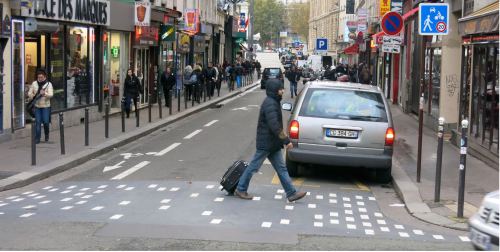Also discussed here: Paris to limit speeds to 30 km/hr over entire city (World Streets: The Politics of Transport in Cities, May 21, 2014)
And here: Oops! What went wrong with "Old Mobility" (World Streets: The Politics of Transport in Cities, Jun. 6, 2010)
Today we review a report from a non-governmental organization which aims to make streets safer for everyone, but particularly children and seniors. Children cannot see cars coming when travelling at more than 20 mph and, because they are small, drivers cannot see them either, making this segment of our population vulnerable. Seniors and those who have difficulty walking quickly are killed by cars at almost twice the rate as their part of the population (21% vs 12.6 %). Speed kills and many arterial roads encourage speeding – the risk of death of hit by a car moving at more than 50 mph is 75% while that drops to 6% at 20 mph.
Streets can be designed to protect pedestrians- by removing lanes, by giving pedestrians clearly marked areas to cross, by enforcing reduced speed limits. The Mayor of Paris, France proposes to forbid driving above 30 kph (about 20 mph) on all city streets, with a few exceptions, which tells you two things: first, their society is aging faster than in US/Canada and, second, the city fathers (or in this case mother) put a greater priority on pedestrian safety then on motorized mobility (the French call that “the old mobility”).

Key Quotes:
“At 20 mph, the risk of death to a person on foot struck by the driver of a vehicle is 6 percent. At 30 mph, that risk of death is three times greater. And at 45 mph, the risk of death is 65 percent—11 times greater than at 20 mph. When struck by a car going 50 mph, pedestrian fatality rates are 75 percent and injury rates are more than 90 percent“
“Where the posted speed limit was recorded, 61.3 percent of pedestrian fatalities were on roads with a speed limit of 40 mph or higher. This figure compares to just 9 percent of fatalities that occurred on roads with speed limits less than 30 mph.”
“The majority of pedestrian deaths occur on arterial roadways, planned and engineered for speeding automobiles with little consideration for the diversity of people—young, old, with and without disabilities, walking and bicycling—who rely on these streets to get them from point A to point B.”
“The nation’s older population will nearly double in size in the next 30 years. The number of racial and ethnic minorities is also projected to grow significantly. These groups, along with children, are disproportionately represented in pedestrian deaths.”
“The most common cause of traumatic brain injury for children aged 5 to 9 is pedestrian injury… A recent study of perceptions of children aged 6 to 11 found that they lack the ability to detect vehicles moving faster than 20 mph. They don’t see the cars coming”
“While comprising 12.6 percent of the total population, adults aged 65 and older account for nearly 21 percent of pedestrian fatalities nationwide from 2003 to 2010.. For those 75 and older, pedestrian fatality rates are even more alarming, with 3.96 fatalities per 100,000 capita.15 People aged 75 years and older account for six percent of the total U.S. population, but more than 12 percent of pedestrian fatalities.”
“Generally, designing for safe, walkable communities begins with understanding how people use— and want to use—streets and public spaces to access destinations. From there flow general considerations such as separate people walking from people driving vehicles; keep traffic speeds low; ensure all sidewalks and curb ramps are accessible to people with disabilities; and clarify where each road user should be expected to travel.”
“The just-elected new Mayor of Paris, Madame Anne Hidalgo, has prepared a revolutionary sustainable mobility project whereby virtually all of the streets of the city will be subject to a maximum speed limit of 30 km/hr….The only exceptions in the plan are a relatively small number of major axes into the city and along the two banks of the Seine”








No comments:
Post a Comment